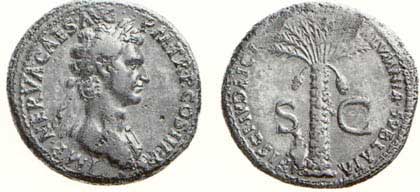Ancient Jewish Coins: Nerva’s Jewish Tax Coin
(96 CE)
In 70 CE, after the fall of Jerusalem, many thousands of Jews were taken to Rome as slaves and others were exiled from Judaea. Rome took over the collection of the annual Jewish head tax, which had been a half shekel (equivalent to two Roman denarii). The Romans collected this tax with much zeal ... so much so that it caused embarrassment to Jews and non-Jews alike.
Following the reign of the Flavians - Vespasian, Titus and Domitian - came the short but liberalizing rule of Nerva (96-98 CE). One of the first reforms he instituted concerned the department responsible for the collection of the Jewish head tax (Fiscus Judaicus), which had previously demanded visible (and public) proof of circumcision. The insulting methods of collecting the tax were abolished, but the tax itself was not.
A large bronze sestertius was issued to commemorate this reform. This scarce coin features a palm tree, that had become symbolic of the Jewish people on the Judaea Capta coins, and the Latin inscriptions “FISCI IVDAICI CALVMNIA SVBLATA” (the calumny of the Jewish tax is removed) and “S C” (by consent of the Senate).
 |
|---|
Nerva, 96 CE ( Brom. 314)
Sources: The Handbook of Biblical Numismatics


